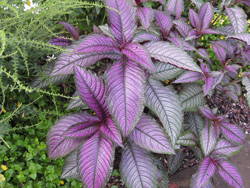Resource Library
Plant of the Week: Persian Shield
The University of Arkansas System Division of Agriculture does not promote, support or recommend plants featured in "Plant of the Week." Please consult your local Extension office for plants suitable for your region.
Plant of the Week
Persian Shield
Latin: Strobilanthes dyerianus

Flowers provide lots of color in the garden but they are fleeting. Foliage color, on the other hand, lasts all season long and can be dramatic. One of the most dramatic plants for high impact color is Persian Shield (Strobilanthes dyerianus).
Persian shield is a tender tropical sub-shrub with large iridescent silvery-purple leaves. Its opposite leaves are to 6 inches long with prominent darker veins and a purple underside. It grows about 3 feet tall and 4 feet wide in a perfect location. The plant is native to Myanmar (Burma) in southern Asia.
Persian shield is a member of the acanthus family, a large group of tropical subshrubs that clearly show their family kinship. All that I know share the characteristic 2-ranked leaves and flowers that are produced in a unique 4-sided bracted terminal inflorescence. Flower color for the family is all over the board with orange, blue and yellow all common. In Strobilanthes blooms are blue, that is when they are produced.
Persian shield is grown for its showy foliage, not its flowers. In fact, flower production in this species is a bit mysterious. Blossoms are seldom seen in gardens but some commercial growers report it sometimes flowers during wintertime, thus interfering with the production of cuttings. But, in controlled experiments, it has been difficult to get it to produce flowers. This species simply doesn’t respond to the usual environmental cues such as the length of the day and nigh, the temperature or overall nutritional status.
Interestingly, some species of Strobilanthes have an unusual kind reproductive biology known as "masting". In these species flowering is highly synchronous with flowers produced at the same time in the same year wherever the plants are grown. The interval between bloom cycles is 7 years in some species while 12 years in others, making them the periodic cicadas of the plant world.
Masting species have evolved to avoid predation of their seed crops. The theory goes that the interval between flowering is so long that a potential predator will not be able to coevolve so that it becomes dependent on the seeds of the species for survival. When masting species do flower they produce enormous amounts of seed and then often the parent plant dies. Bamboos are the best-known masting plants with flowering cycles often spaced at 30 to 50 year intervals. Persian shield may not show classic masting kind of flowering behavior but its flowering biology is not yet clearly understood.
Members of the acanthus family, including Persian shield, share another common cultural trait. They all like moist soil, high humidity and bright light but not necessarily direct sun during the heat of the day. If they get dry they immediately flag and if this happens too often plant performance will be poor. Because of its need for high humidity and bright light this tropical species is not a very good houseplant during winter months unless grown in a sunroom or solarium.
In the summertime garden Persian shield is often used as a bold accent plant in the border or in containers. Plant them out in late spring after the soil has warmed. Plants should be pinched in the early stages of growth to keep them more compact. It has no common pest problems.
By: Gerald Klingaman, retired
Extension Horticulturist - Ornamentals
Extension News - October 16, 2009
The University of Arkansas System Division of Agriculture does not maintain lists of retail outlets where these plants can be purchased. Please check your local nursery or other retail outlets to ask about the availability of these plants for your growing area.